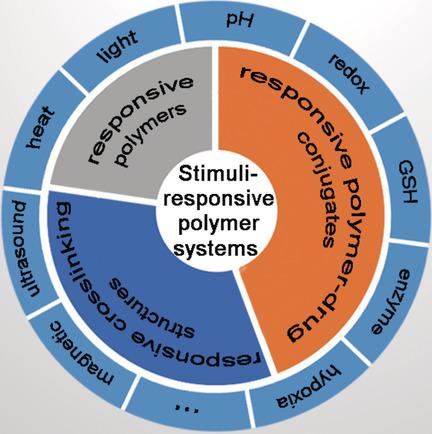当前位置:
X-MOL 学术
›
ChemBioChem
›
论文详情
Our official English website, www.x-mol.net, welcomes your
feedback! (Note: you will need to create a separate account there.)
Strategies To Design and Synthesize Polymer-Based Stimuli-Responsive Drug-Delivery Nanosystems.
ChemBioChem ( IF 2.6 ) Pub Date : 2020-02-21 , DOI: 10.1002/cbic.201900550 Xing Qin 1 , Yongsheng Li 1
ChemBioChem ( IF 2.6 ) Pub Date : 2020-02-21 , DOI: 10.1002/cbic.201900550 Xing Qin 1 , Yongsheng Li 1
Affiliation

|
The emergence and development of nanomedicine have alleviated problems existing in traditional chemotherapy drugs, such as short lifetime, concomitant side effects, and weak tumor-targeting capability. Nevertheless, the further applications of drug-loaded nanocarriers are still limited by their premature leakage, weak targeting capability, and insufficient intracellular release. In past decades, various nanocarriers, including gold nanoparticles, porous silica nanoparticles, carbon-based nanoparticles, micelles, liposomes, and polymer-drug conjugates, have been intensively investigated for tumor therapy. Among these, polymer-based nanocarriers have attracted more attention due to their biocompatibilities and capability of being modified for stimuli-responsive drug release. In this review, three popular strategies to design and synthesize polymer-based stimuli-responsive nanocarriers are discussed. The discussion goes from stimuli-responsive polymers with responsive backbones or modified by responsive functional groups for drug encapsulation and release to polymer-drug conjugates with responsive covalent linkages. In particular, due to the facile synthetic processes and mild reaction conditions for crosslinked structures, the latest progress in responsive crosslinked structures is emphasized. Finally, future perspectives for these nanomaterials are given, which are expected to provide inspiration for researchers to design more effective and safer tumor-killing nanomedicines.
中文翻译:

设计和合成基于聚合物的刺激响应药物递送纳米系统的策略。
纳米药物的出现和发展减轻了传统化学疗法药物中存在的问题,例如寿命短,伴随的副作用和靶向肿瘤的能力较弱。然而,载有药物的纳米载体的进一步应用仍然受到其过早泄漏,靶向能力弱和细胞内释放不足的限制。在过去的几十年中,已经广泛研究了各种纳米载体,包括金纳米颗粒,多孔二氧化硅纳米颗粒,碳基纳米颗粒,胶束,脂质体和聚合物-药物缀合物,用于肿瘤治疗。在这些之中,基于聚合物的纳米载体由于其生物相容性和被修饰用于刺激响应性药物释放的能力而引起了更多的关注。在这篇评论中,讨论了设计和合成基于聚合物的刺激响应纳米载体的三种流行策略。讨论从具有响应性主链或被响应性官能团修饰用于药物封装和释放的刺激响应性聚合物发展到具有响应性共价键的聚合物-药物缀合物。特别地,由于容易的合成过程和温和的交联结构的反应条件,强调了响应性交联结构的最新进展。最后,给出了这些纳米材料的未来展望,有望为研究人员设计更有效,更安全的杀肿瘤纳米药物提供启发。讨论从具有响应性骨架的刺激响应性聚合物或通过响应性官能团修饰的用于药物封装和释放的刺激响应性聚合物发展到具有响应性共价键的聚合物-药物缀合物。特别地,由于容易的合成过程和温和的交联结构的反应条件,强调了响应性交联结构的最新进展。最后,给出了这些纳米材料的未来展望,有望为研究人员设计更有效,更安全的杀肿瘤纳米药物提供启发。讨论从具有响应性骨架的刺激响应性聚合物或通过响应性官能团修饰的用于药物封装和释放的刺激响应性聚合物发展到具有响应性共价键的聚合物-药物缀合物。特别地,由于容易的合成过程和温和的交联结构的反应条件,强调了响应性交联结构的最新进展。最后,给出了这些纳米材料的未来展望,有望为研究人员设计更有效,更安全的杀肿瘤纳米药物提供启发。强调了响应性交联结构的最新进展。最后,给出了这些纳米材料的未来展望,有望为研究人员设计更有效,更安全的杀肿瘤纳米药物提供启发。强调了响应性交联结构的最新进展。最后,给出了这些纳米材料的未来展望,有望为研究人员设计更有效,更安全的杀肿瘤纳米药物提供启发。
更新日期:2020-02-21
中文翻译:

设计和合成基于聚合物的刺激响应药物递送纳米系统的策略。
纳米药物的出现和发展减轻了传统化学疗法药物中存在的问题,例如寿命短,伴随的副作用和靶向肿瘤的能力较弱。然而,载有药物的纳米载体的进一步应用仍然受到其过早泄漏,靶向能力弱和细胞内释放不足的限制。在过去的几十年中,已经广泛研究了各种纳米载体,包括金纳米颗粒,多孔二氧化硅纳米颗粒,碳基纳米颗粒,胶束,脂质体和聚合物-药物缀合物,用于肿瘤治疗。在这些之中,基于聚合物的纳米载体由于其生物相容性和被修饰用于刺激响应性药物释放的能力而引起了更多的关注。在这篇评论中,讨论了设计和合成基于聚合物的刺激响应纳米载体的三种流行策略。讨论从具有响应性主链或被响应性官能团修饰用于药物封装和释放的刺激响应性聚合物发展到具有响应性共价键的聚合物-药物缀合物。特别地,由于容易的合成过程和温和的交联结构的反应条件,强调了响应性交联结构的最新进展。最后,给出了这些纳米材料的未来展望,有望为研究人员设计更有效,更安全的杀肿瘤纳米药物提供启发。讨论从具有响应性骨架的刺激响应性聚合物或通过响应性官能团修饰的用于药物封装和释放的刺激响应性聚合物发展到具有响应性共价键的聚合物-药物缀合物。特别地,由于容易的合成过程和温和的交联结构的反应条件,强调了响应性交联结构的最新进展。最后,给出了这些纳米材料的未来展望,有望为研究人员设计更有效,更安全的杀肿瘤纳米药物提供启发。讨论从具有响应性骨架的刺激响应性聚合物或通过响应性官能团修饰的用于药物封装和释放的刺激响应性聚合物发展到具有响应性共价键的聚合物-药物缀合物。特别地,由于容易的合成过程和温和的交联结构的反应条件,强调了响应性交联结构的最新进展。最后,给出了这些纳米材料的未来展望,有望为研究人员设计更有效,更安全的杀肿瘤纳米药物提供启发。强调了响应性交联结构的最新进展。最后,给出了这些纳米材料的未来展望,有望为研究人员设计更有效,更安全的杀肿瘤纳米药物提供启发。强调了响应性交联结构的最新进展。最后,给出了这些纳米材料的未来展望,有望为研究人员设计更有效,更安全的杀肿瘤纳米药物提供启发。











































 京公网安备 11010802027423号
京公网安备 11010802027423号